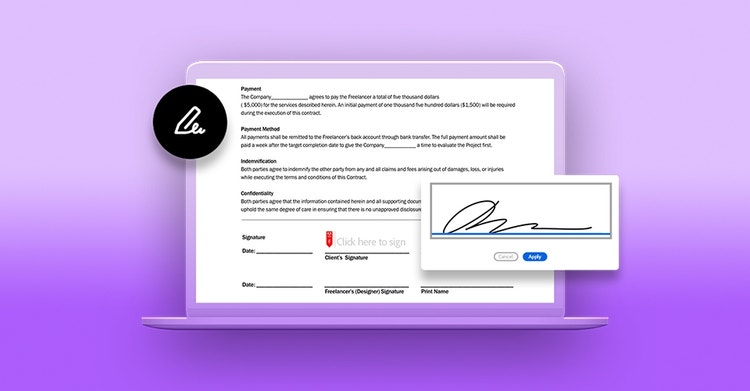Adobe Acrobat Sign
A fixed price contract guide with templates and examples.
Set up projects simply and easily by quoting a single price for the job. Learn the pros and cons of fixed price contracts and how to create your own.

What is a fixed price contract?
A fixed price contract (or fixed price agreement contract) outlines a single set price for a project, no matter the time, labor, or resources it takes to complete the job. These types of contracts are often used in construction projects or contracts with the U.S. government because they are straightforward with one bottom line, thus avoiding potential cost overruns. While fixed price development contracts come with higher risks for contractors, they can be an efficient and lucrative way to handle project agreements.
When to use a fixed price contract.
A fixed price contract is a good fit if you are working on a project with a clear scope of work and you can accurately estimate labor and material costs.
For example, some construction contracts may have daily or hourly rates that they add to the total project cost in a straightforward way. Others, like time and materials contracts or cost-plus contracts, include a fixed fee in addition to a cost reimbursement contract based on the actual cost of the work. And, while very similar to a fixed price, a lump sum contract can fluctuate based on factors such as indirect costs, subcontractor labor, or changes in procurement costs. But a fixed price contract is the only type that operates on a single flat fee, which brings simplicity to the paperwork.

Benefits and risks of fixed price contracts.
It’s simple and easy.
Fixed price contracts keep transactions and paperwork simple for all parties to understand. One flat fee is easier to work with than the administrative burden of tracking each expense throughout the course of a project. And, on the buyer’s side, one fee makes it much easier to budget for projects.
But it’s riskier for vendors.
If a project comes in under budget, a contractor can save a lot of money by using a fixed price contract. On the other hand, construction projects often encounter unexpected costs that can get expensive quickly.
Project management teams must have shrewd budgeting skills in order to provide a quote that comes as close as possible to the actual cost. If a vendor leaves too much padding in the total cost for contingencies, they may lose out on business. But if the vendor underestimates the pricing or scope of work, they can end up losing money on the job.
Types of fixed price contracts.
The beauty of the fixed price contract is that there are no special subtypes or nuances to hassle with. However, if a contractor is working for the U.S. government on a federal project, the rules are different.
Under the Federal Acquisition Regulation (FAR), the government may choose from a few special types of fixed price contracts, all of which are designed to let the government control costs, maximize taxpayer dollars, and put more of the risk on the vendor’s side. These special types of fixed price contracts include:
- Firm fixed-price contracts
- Fixed-ceiling-price contracts with price redetermination
- Fixed-price contracts with economic price adjustment
- Fixed-price incentive contracts
- Firm fixed-price level-of-effort contracts

What to include in your fixed price contract.
- Name and contact information of the project owner and the contractor.
- Legal description of the property being worked on and a detailed description of the work to be completed.
- Completion date and date of final payment.
- Terms for contract termination and consequences of breach of contract by either party, and terms for unforeseen accidents.
- Change orders or a policy for adjusting the contract .
- Hold harmless clause outlining details of warranties, liability, and indemnification.
- Required licenses, permits, and insurance, as well as terms for access to the property and other necessary logistics.
- Total contract price or terms for calculating construction cost and payment terms.
- Right to withhold payment by the contract owner, and any terms for the condition of the property and disposal of items upon completion.
- Signatures and date of signatures from both parties.

Make and sign digital contracts with Adobe.
Fixed price contracts lend themselves to quick and easy signing, and for fast and simple contracts without the hassle, turn to e-docs. Everyone can view, comment on, and edit drafts in real time so that all parties are on the same page. With Adobe Acrobat Sign you can send your contract to be signed in just a click, and the other parties can review and sign right from their phone or laptop. Get started with your own contract templates today.
